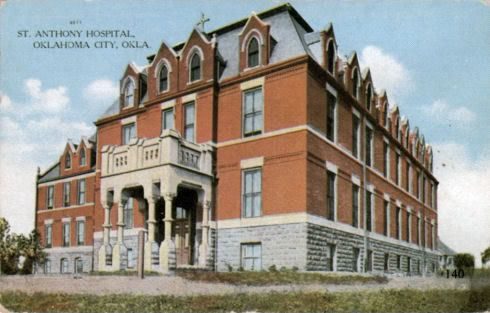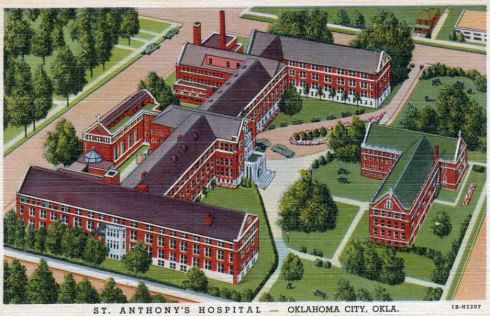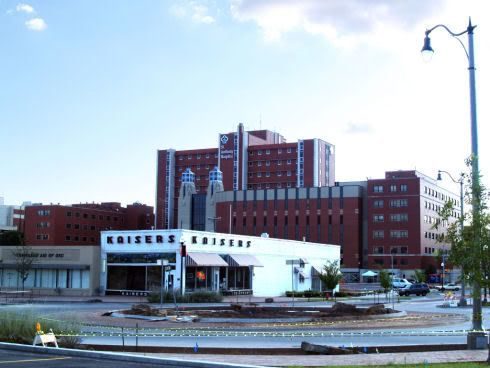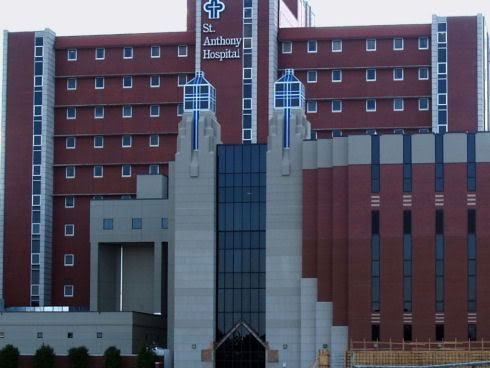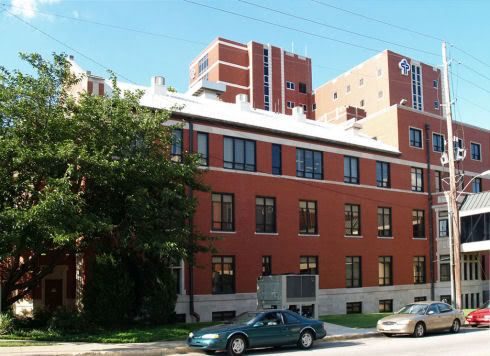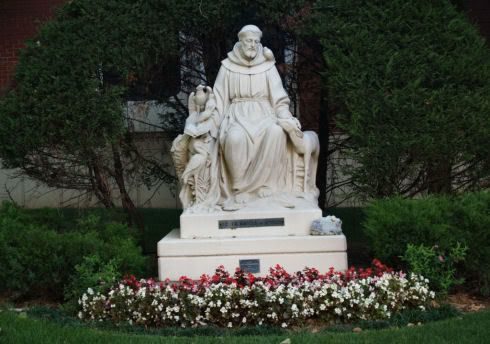Saints, St. Ann’s, St. Anthony’s, Saint A’s, whatever you want to call it, was established in Oklahoma City in 1898, 9 years after the Land Run. Its first “permanent” home, finished in 1899, is shown below, at 1000 N. Lee, then outside Oklahoma City’s limits.
Credit Vanished Spendor by Jim Edwards & Hal Ottaway
(Abalache Book Shop Publishing Co. 1982)
It was Oklahoma City’s first “permanent” hospital and was located near downtown in the area called “Midtown” today as is shown in the Oklahoma County Assessor’s 2005 aerial view shown below. Plaza Court, Kaisers (Grateful Bean), and the Federal Campus are shown for reference.
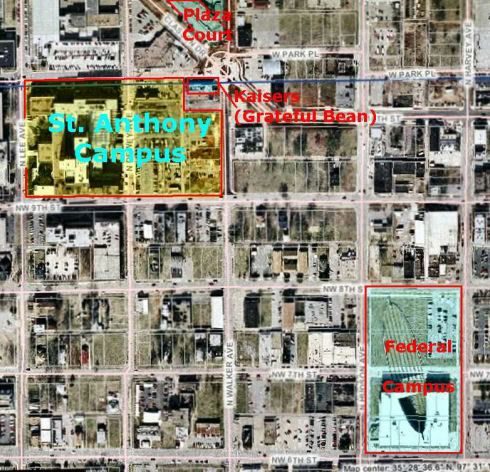
Modest Beginnings. How did it get started? A pair of Roman Catholic Franciscan nuns (Sisters Beata Vinson and Clara Schaff) traveled to Oklahoma City from Missouri in the spring of 1898. They were looking to raise funds here for a hospital there (in Maryville, Missouri), apparently thinking that 9 years after the Land Run they’ed find some benefactors here, and they sought permission from the local priest, Rev. D.I. Landslots, to solicit funds for that purpose. Whether he gave permission or not I don’t know, but, at the least, he requested and charged the Sisters to go back to Maryville and carry a request that the Order to establish a permanent hospital here … none existed at the time in the city or even in Oklahoma Territory, according to an April 26, 1998, Oklahoman article.
It worked. In July 1898, 4 Sisters returned and rented a pair of houses on NW 4th (one a residence, the other a temporary hospital … which would later become the location of the Murrah Building … so the ties between the Order and the later Murrah Building were/are longstanding).
When the initial hospital opened, it had no electricity, sewage, running water (water had to be hauled by the nuns from 4 blocks away) or natural gas. In fact, it had to close in November 1898 because of those problems.
A very nice summary of history is gleaned from the April 28, 1998, Oklahoman article mentioned above … it commemorated St. Anthony’s 100th anniversary. Click the image below for a readable version.
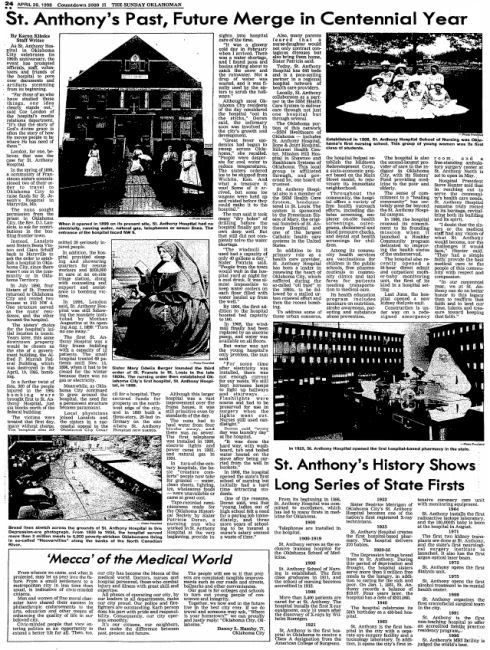
The main article says that phones were installed in 1900, electricity in 1902, and natural gas in 1904, and that the hospital’s entrance faced NW 9th.
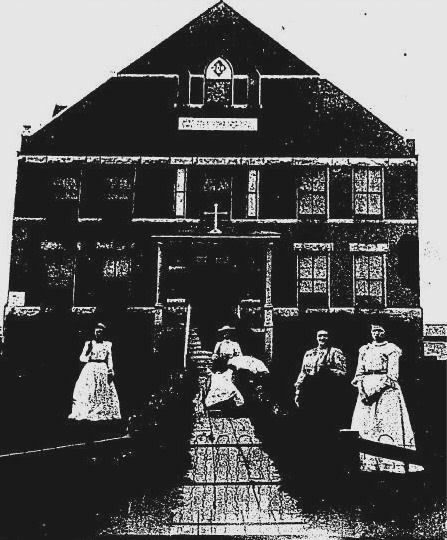
The same article notes that the St. Anthony School of Nursing was established in 1908, the first graduating (1911) class being shown below.
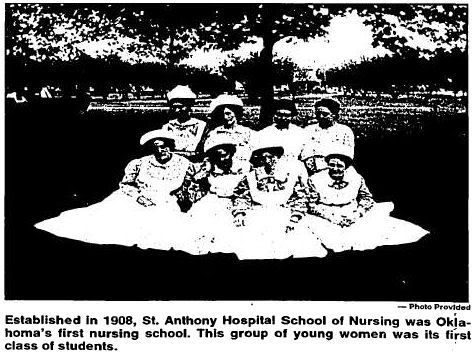
The Sisters had been instructed by their Mother Superior Augustine in her August 1, 1898 mandate, “Turn no one away.” In the aftermath of the Murrah Building bombing, much beyond the death of Sister Augustine, 300 of the people injured in the 1995 Murrah bombing were brought to Saint Anthony’s, the hospital nearest to the Murrah Building, and many were treated without charge. During the Great Depression, hospital Sisters served more than 2,000,000 free meals to the hungry. The hospital’s bank balance was $19.07 on January 1, 1931 … four years later, it was in debt by $331,060.
But, I digress! St. Ann’s continued to grow after its 1899 facility was constructed. Below, images from my postcard collection show what Saint A looked like in the 1940s.
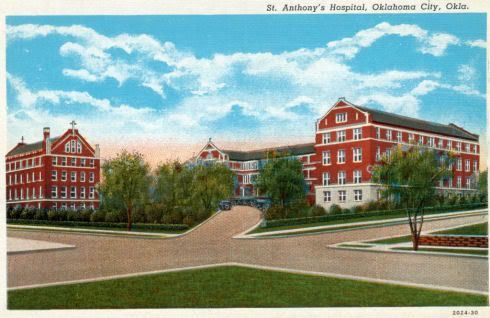
The above is Doug Dawgz hospital of birth in 1943! Hooahh! (Sorry … had to do that.)
The Competition. Although St. Anthony’s was the first, other hospitals came to occupy what we now consider “close-in” space. Some are shown below.
Credit Vanished Spendor by Jim Edwards & Hal Ottaway
(Abalache Book Shop Publishing Co. 1982)
Rolater Hospital, 325 NE 4th, circa early 1900s
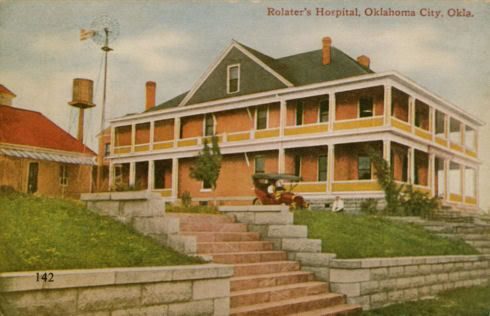
Wesley Hospital, 12th & Harvey (1911)
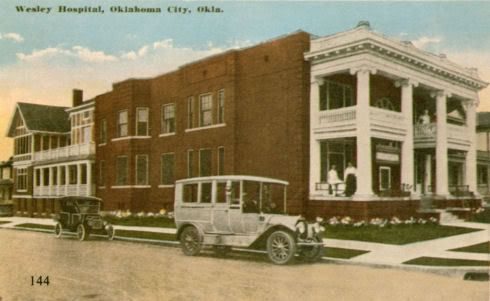
Credit Vanished Spendor III by Jim Edwards, Hal Ottaway & Mitchell Oliphant
(Abalache Book Shop Publishing Co. 1985)
The 1927 Wesley Hospital, 12th & Harvey
Became the Presbyterian Medical Center in 1964
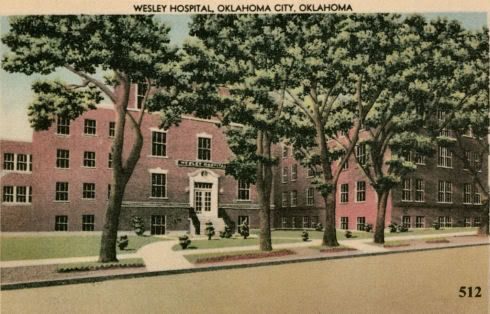
City Hospital, 401 NE 2nd, 1912, apparently intended for charity,
later called “Post-Graduate Hospital”, later used by the Dept. of
Health for laboratory space, in the 1940s the Stiles Community Center
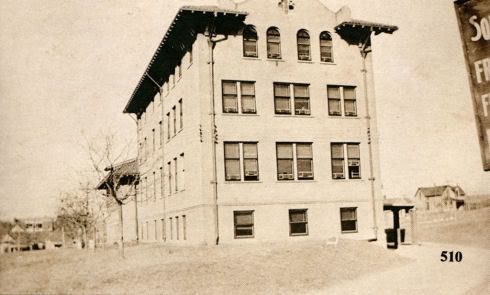
Credit Vanished Spendor II by Jim Edwards & Hal Ottaway
(Abalache Book Shop Publishing Co. 1983)
Originally the State Baptist Hospital (1916), it
became Oklahoma General Hospital in 1922, Mercy
Hospital in 1947. Before Mercy moved in 1974, it
occupied the block between Dewey & Walker, NW 13 & NW 12
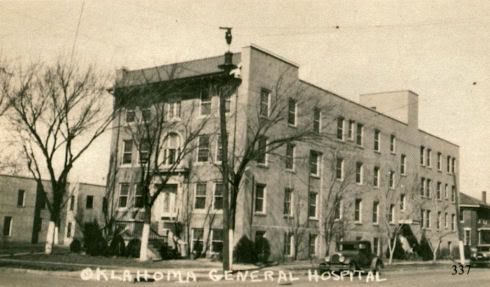
From My PostCard Collection
University Hospital on NE 13th (1919)
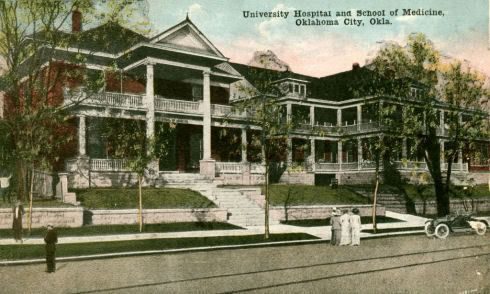
Polyclinic Hospital, NW Corner of 13th & Robinson (1929)
Later (?), the building was demolished and a newer facility
was built which has gone by various names, now Kindred Hospital
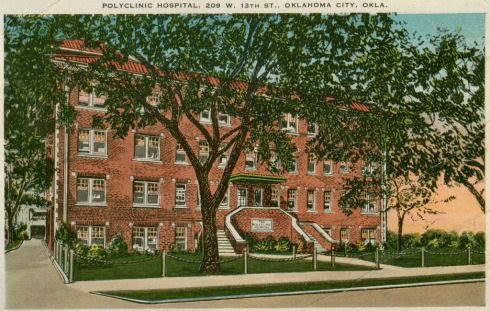
St. Ann Continues To Grow. St. Anthony’s continued to grow over the years. The pic below is a rendering appearing in the March 16, 1958, Oklahoman showing then existing plans.
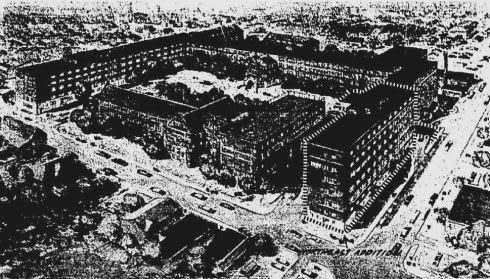
Not counting clinics (e.g., the McBride Clinic) and smaller hospitals (Kindred Hospital), St. Anthony’s became the sole surviving major hospital in the city-center area. “Presbyterian” moved to NE 13th & Lincoln and is now part of the University of Oklahoma health care complex. Mercy moved to the far northwest on Memorial Road in 1974. Also moving or closing were many businesses, shops, etc., and the area around St. Anthony’s became something less than desirable.
In 2002-early 2003, talk was that St. Anthony’s might be moving also (I seem to recall that it might relocate to the north Moore area or something in that general vicinity which would not only remove the remaining major hospital from city-center but would leave yet another empty structure in the Midtown area, and a huge one at that.
But, that didn’t happen. An August 1, 2003, Oklahoman article by Steve Lackmeyer reported a deal being offered to keep St. Anthony’s downtown.
An October 25, 2003, Oklahoman article by Bryan Dean reported the good news:
Hospital staying downtown
St. Anthony Hospital and local government officials signed a deal Friday that could trigger more than $200 million of investment in the MidTown area and bring cutting edge cancer technology to the state.
The agreement to keep St. Anthony at its downtown location was signed less than four months after the hospital said it would either renovate its campus at NW 10 and Lee Avenue or move to another part of town.
“You cannot stress too much the importance of this day,” County Commissioner Stan Inman said. “We have actually avoided a financial disaster for downtown Oklahoma City and this entire county, if not the whole state of Oklahoma.”
The hospital’s main concerns were highway access, crime and blight in the area and a state Medicaid reimbursement formula that penalizes older hospitals.
Local officials have promised to correct neighborhood issues and will ask the state Transportation Department to help with highway access.
Steve Hunter, president and chief operating officer of SSM Healthcare, the hospital’s parent company, said he was surprised by the quick reaction of local officials.
“My expectation was that this thing was going to take forever,” Hunter said. “To have this thing basically done in less than six months, I think shows a commitment by a lot of people.”
State officials said they may have a solution to the Medicaid reimbursement issue.
Under the current formula, older hospitals tend to receive lower reimbursements because of a longer history with the Medicaid program, which is overseen locally by the Oklahoma Health Care Authority.
St. Anthony officials complained that the formula was discriminatory.
Nico Gomez, spokesman for the Oklahoma Health Care Authority, said a proposal before the authority’s board would raise all hospitals’ reimbursement rates to the state median before giving an across the board increase of 2 percent.
With most of its concerns addressed, the hospital plans to invest $200 million into its campus. City and county initiatives will improve the look of the area surrounding the hospital.
The deal struck was obviously a community-wide deal … the pic below (taken by Paul Hellstern of the Oklahoman shows the agreement’s signators to be (left to right): Fred Hall, board chairmen of Downtown Oklahoma City, Inc.; Stanton Youg, chairman of the Urban Renewal Authority; Roy Williams, executive VP of the Okc Chamger of Commerce; Steve Hunger, president of St. Anthony Hospital; Stan Inman, Oklahoma County Commissioner; and Okc Mayor Kirk Humphreys.

Midtown Resurgence. It certainly did no harm that Greg Banta became the primary mover and shaker in the Midtown area, together with the guy bankrolling many of the Banta Group’s Midtown projects. Largely, that’s another story for another day.
But it certainly does no harm that the Banta Group is restoring the historic Plaza Court, Oklahoma City’s first shopping center, immediately northeast of the hospital’s plaza. The images below were taken on July 20, 2007. Click any pic for a larger view.
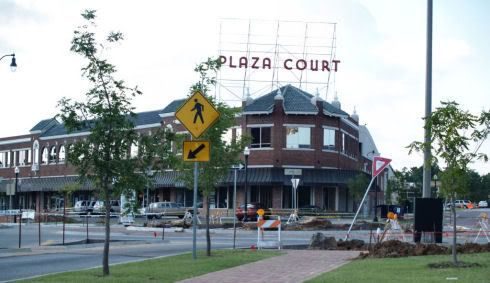
The historic Kaiser’s is now the Grateful Bean owned by Peter Schaeffer. It closed for a time in October 2004 because of construction of the traffic circle (aka “roundabout”) … but it did reopen. The building is more than 90 years old, and for decades was home to Kaisers Ice Cream. Schaffer bought the building in 1992, remodeled it, and got it listed on the National Register of Historic Places. He turned the landmark into a nonprofit restaurant that hired people who were either marginally employed or chronically unemployed. Though he feared it might not reopen, as you can plainly see, it did! Good for St. Anthony’s, Peter’s project, and for all of us.
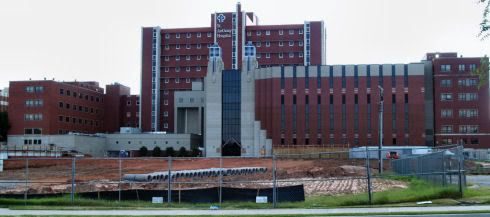
A Parking Garage on the South Side
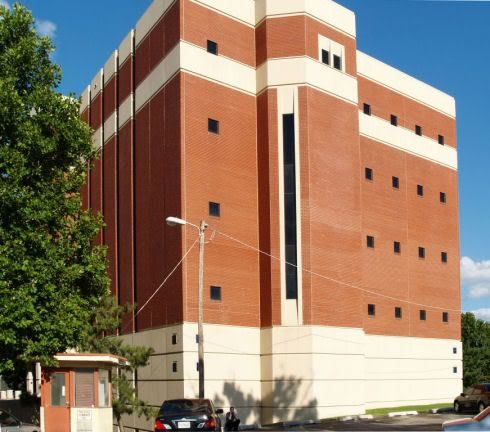
On the West Side Looking Southeast
And, Of Course, St. Francis Himself,
Patron Saint of the Religious Order
That Started St. Anthony’s in 1898
Today, St. Anthony’s is reported to be Oklahoma City’s largest hospital. I’m glad that I live nearby!

